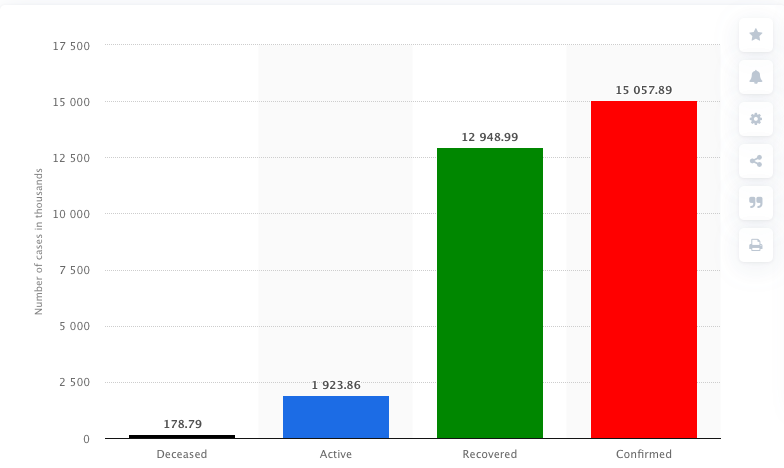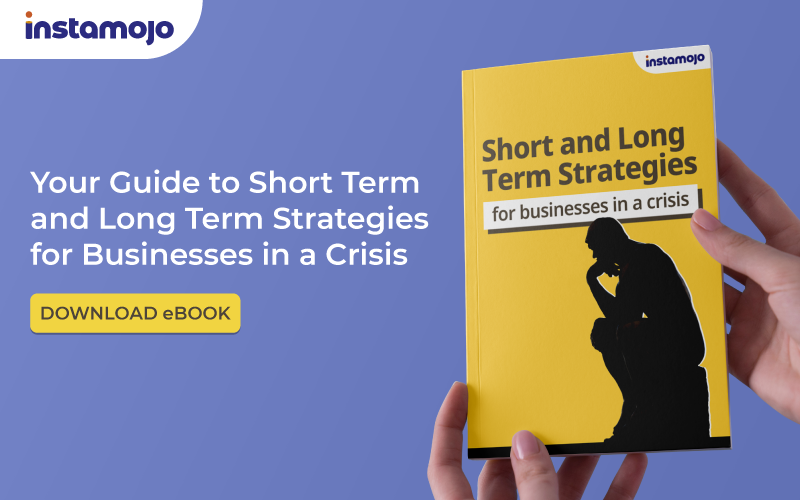Small businesses in India are gearing up for the second wave of COVID-19, a virus that severely impacted businesses in 2020. This time, however, businesses will be better prepared for the worst. In this blog, we will discuss how your business can fight the virus and keep business going as usual.
In this blog, we will discuss:
- How the first wave of COVID impacted businesses in India – an overview
- What small businesses need to expect with the new strain
- How to stay prepared for the second wave of COVID – 7 tips
How COVID impacted businesses in India – an overview
Currently, India has reported over 15 million confirmed cases of Coronavirus (COVID 19). Out of these, over 12.9 million patients had recovered, while 178 thousand cases were fatal.
The first wave impacted businesses’ cash flow, sales, and overall, morale. Over 73% of small businesses in India saw a shortage of cash flow during the first pandemic lockdown.
The most impacted sector was travel, real estate, and automobile due to travel restrictions, reduced spending, and lockdowns. The aviation sector alone incurred a loss of Rs. 85 billion in just one year.
But these numbers should not demotivate you. If your business is prepared for the worst, you have nothing to fear.
How will the second wave of COVID affect small businesses?
The country is in chaos, and for business owners, this could mean trouble. States have announced a lockdown and many shipping services have been put on hold. Last year, these sudden changes came as a shock to Indian MSMEs. The Government scrambled to give financial provisions to ease business operations, but it was not enough. This time, the second wave could bring:
- A sudden lockdown – As per several news reports, there are public lockdowns and curfews imposed on states. Businesses with an offline store or office will need to pull shutters down and carry out work from home till the lockdown is lifted.
- Travel restrictions – If you require to travel across state lines for work, a second wave could stop it from happening.
- COVID test – Everyone looking to get back to work or travel across states might need a negative COVID test or a vaccination report
- Shortage of working capital – Once again, unaware businesses might be caught in a cash crunch due to uncertainty and sudden Government imposed restrictions.
- Manufacturing units shut down – Due to another slow decline in demand, supply will come down and this could result in manufacturing units closing down for a while
- Pause on shipping services – Due to the lockdown, several express shi[ping services will put a pause on delivery.
In last 24 hours, India recorded 16,946 coronavirus cases, 17,652 recoveries, a fall of 904 in net active cases and 198 deaths, taking India’s COVID-19 case load to 1.05 crore, while active cases stood at 2.14 lakh#coronavirus #COVID #COVIDー19 pic.twitter.com/pQFWjm68xl
— Business Today (@BT_India) January 14, 2021
How to stay prepared for the second wave of COVID – 6 tips
It seemed like the Government and the public had everything in control up until last month. Now, hospital beds are scarce and lockdowns are being imposed hastily. Here’s how you can ensure your small business does not get adversely affected by these circumstances.
1. Apply for Government services
Loans:
Did you apply for a Government-aided financial scheme in 2020? A lot of the bank-providing schemes are still active for small businesses. If you are speculating whether to approach a bank or public sector lender for a loan, it is not a bad idea. There are several Government schemes that your business can apply for. A lot of the schemes are being extended for MSMEs to meet any financial requirements at the onset of the second wave of COVID-19. For example – The Pradhan Mantri Garib Kalyan Package insurance scheme, which provides a cover of Rs 50 lakh for fatalities of health workers battling Covid-19, has been renewed for one year starting March 24.
Resources to help apply for financial aid:
- 5 Government programs to accelerate your eCommerce growth
- Everything you need to know about the Government’s new compliance platform
- How to access and apply for the Government’s emergency credit schemes
- Everything you can sell on the Government E-marketplace when demand is low
Shipping:
In case shipping services are paused and you have orders to deliver, approach India Post. Thilak Desingh, a used-books seller and entrepreneur, had pending orders right when the first lockdown took place. Instead of apologizing to his customers and issuing a refund, Thilak approached India Post to courier a few urgent orders to the customers. He was even able to courier books to Kashmir, at the beginning of the pandemic.
Find out how to catch hold of shipping services for your products. Choose the ideal shipping partner that suits your business; preferably one that caters to tier 2 and tier 3 towns.
How can you run a logistics business in a lockdown? This Government-aided policy guide can help
2. Establish safety guidelines for employees
If you run a business with a team of employees, keep them informed of all the latest updates from the Government.
According to Rashi Vidyasagar – a professional therapist, a pandemic can cause employees to feel the strain of uncertainty, work pressure, and managing work and business from home. After the first strain of COVID resulted in over 6 million Indians losing their jobs, companies should attempt to pay heed to employee mental health, and practice empathy.
How can you, as a business owner and leader do this?
- Stay updated on verified information regarding vaccines, oxygen supplies, and medication. Follow updates on social media from municipal bodies and share relevant information with your team.
Here is the list of vaccination centres that will be fully/partly functional or non-functional owing to limited supply of vaccine.#JabToBeatCorona pic.twitter.com/RwjNLT8GLe
— माझी Mumbai, आपली BMC (@mybmc) April 22, 2021
2. Work from home can result in burnout as there is no work-life balance or a routine anymore. This is a crucial time for leaders to keep aside the “hustle” mentality and instead, allow their employees to find the time to relax and take care of themselves too.
Everyone in India today is in some version of Covid crisis directly and indirectly.
It’s important that every leader empathizes and makes work less stressful for the team and for the team to share the burden of affected team members.
This too shall pass.
— Kunal Shah (@kunalb11) April 20, 2021
3. Reach out to COVID positive employees and provide them with the assistance they need. Prepare for a financial insurance policy that assists employees in times of need. For example – just yesterday, the UP Government has decided to issue a 28-day paid leave for Government employees who are COVID positive. The second wave of COVID has resulted in immense financial and emotional distress for the public, so it helps to be an empath.
3. Track vendors and suppliers
Last year, many businesses lost their valuable vendor lists due to lost invoices, unpaid fees, and manufacturing issues. This time, ensure you keep an e-invoice of all conversations and transactions with vendors. It comes useful when you plan to apply for an Input Tax Credit with GST. IT will be tough enough to manage money in a pandemic, it should not result in late payment or penalty for GST because of fake/incomplete invoices.
Unsure how to get started on maintaining invoices? Check out these 5 free invoice templates you can start with.
4. Keep cash in hand
Working capital was one of the most problematic items for businesses during the first wave. There were little to no wages to pay workers, factories shut down and even huge conglomerates did not pay their workers their due. To avoid this, keep money in hand. You can maintain a positive cash flow by:
- Maintaining a clear account of inventory. Keep a close check on all the assets your business holds. Check out these inventory management tools to start with.
- Spend less on plant and machinery and huge assets, and instead, focus on short-term goals.
5. Learn new skills to run your business
Last year, many business owners found a little extra time to themselves due to lockdown. If this should happen again, you need to upskill and learn something new to grow your business.
Entrepreneurs need to stay ahead of the game without compromising on daily business goals. Pick up an online course with mojoVersity – a free e-learning platform for small businesses.
mojoVersity courses are tailor-made to help businesses handle anything that comes their way. You learn about GST, MS Excel, Finding funds, email marketing, public speaking, and more!
For example – A business lesson from COVID every entrepreneur can agree upon is – no business plan is final. The pandemic forced several businesses to ‘pivot’ and erase the whiteboard. For small businesses that are not familiar with how to do so, our new online course on mojoVersity specifically addresses this issue.
Also, if you set up a new business and you are handling money on your own for the first time, it helps to know a little accounting. Learn the basics of business accounting for free to manage your money better.
Take a look and sign up for FREE entrepreneurial courses on mojoVersity – exclusively made for the MSME entrepreneur.
6. Set up an online store
A 2020 eCommerce report curated by our team predicts some of the most popular trends MSMEs need to watch out for in the wake of the first wave of COVID. The one that stuck out was the rapid and almost unstoppable growth of eCommerce in India. As of 2020, eCommerce saw a 200% jump in both sales and volume.
So if you do not like seeing the shutters closing down on your offline store/office, set up your business online. An online store platform like Instamojo allows you to set up for free before you decide to upgrade to one of our premium plans. If you wish to set up your online store for free, this short tutorial will help you get started.
Once customers set up an online store and upgrade it, they found several benefits like –
- Marketing and SEO tools to help them reach customers across the country
- Abandoned cart emailers to convert unsure customers into buyers
- Shipping services like mojoXpress
- Themes to give your store a professional, aesthetic look
- 24*7 customer support
- A ‘Do-it-for-me’ model that allows our team to set up the store for you
- The in-built payment gateway for quick and easy payments
- Legal policies and apps to help with compliance
- Categories, variants, and features for a more enhanced UI experience
If you are wondering by now if any of this makes sense, hear it from our COO Akash Gehani himself. His thoughts and tips have been compiled into an extensive eBook – one that will help you manage your business in a crisis. You can download the ebook here.



